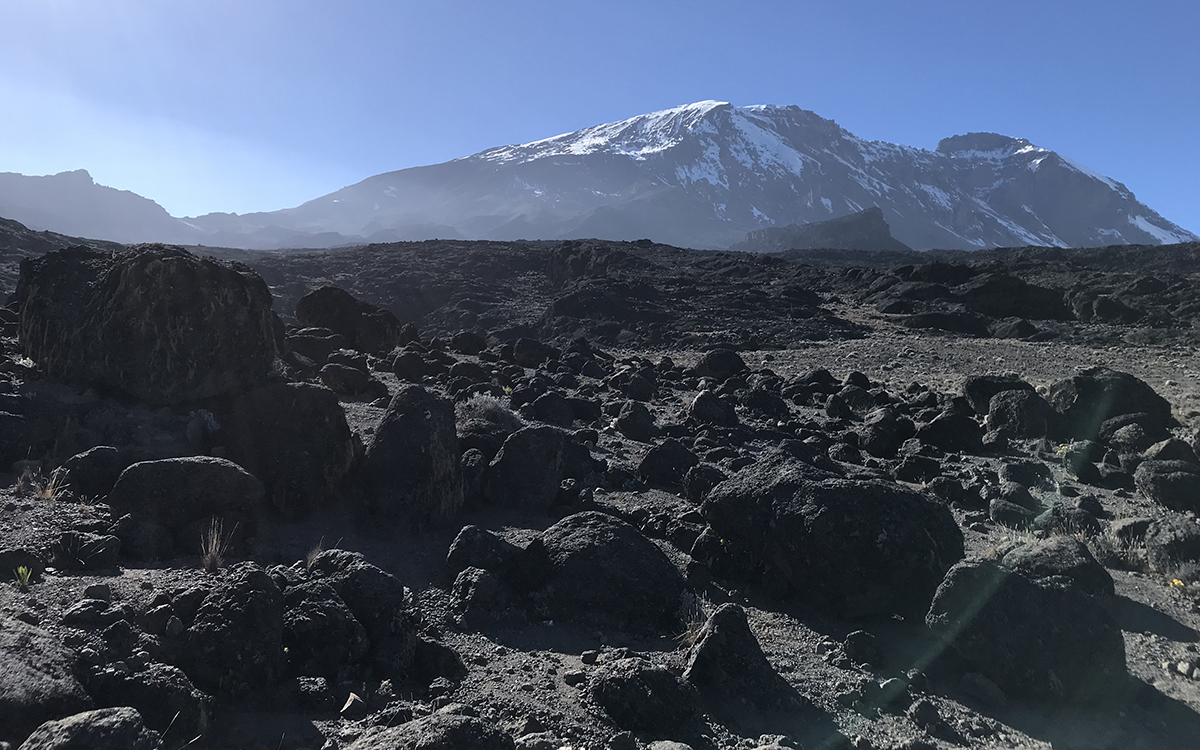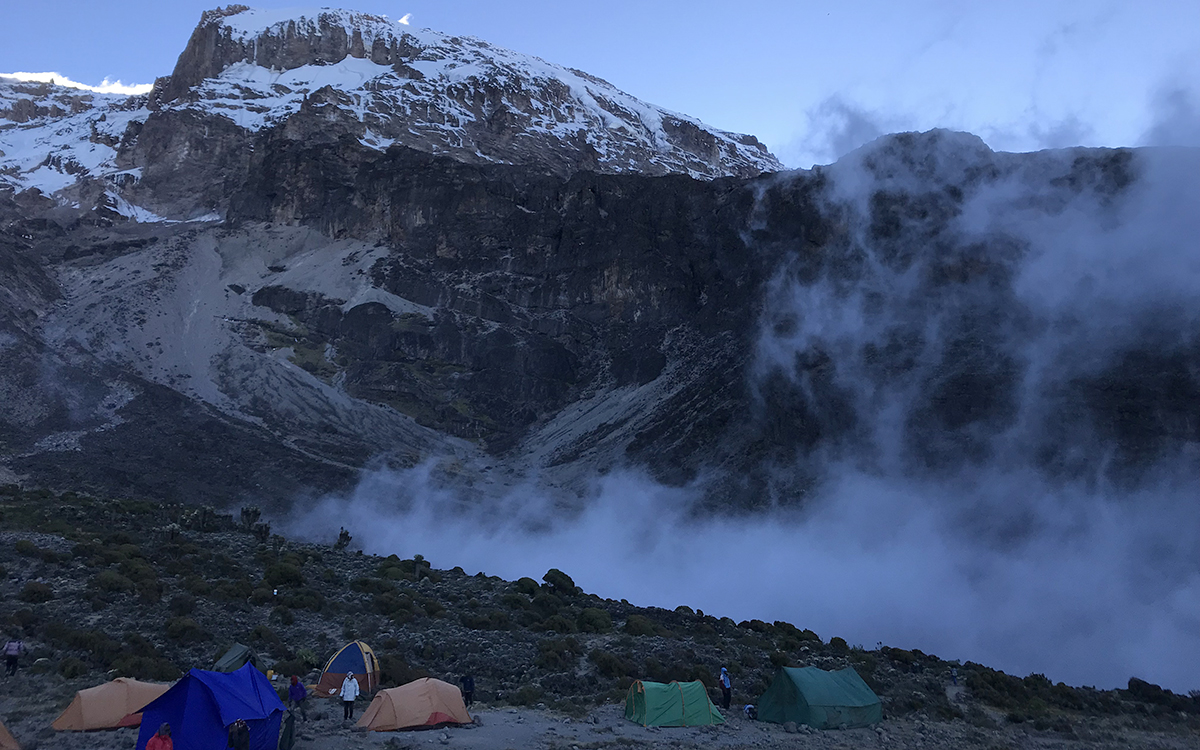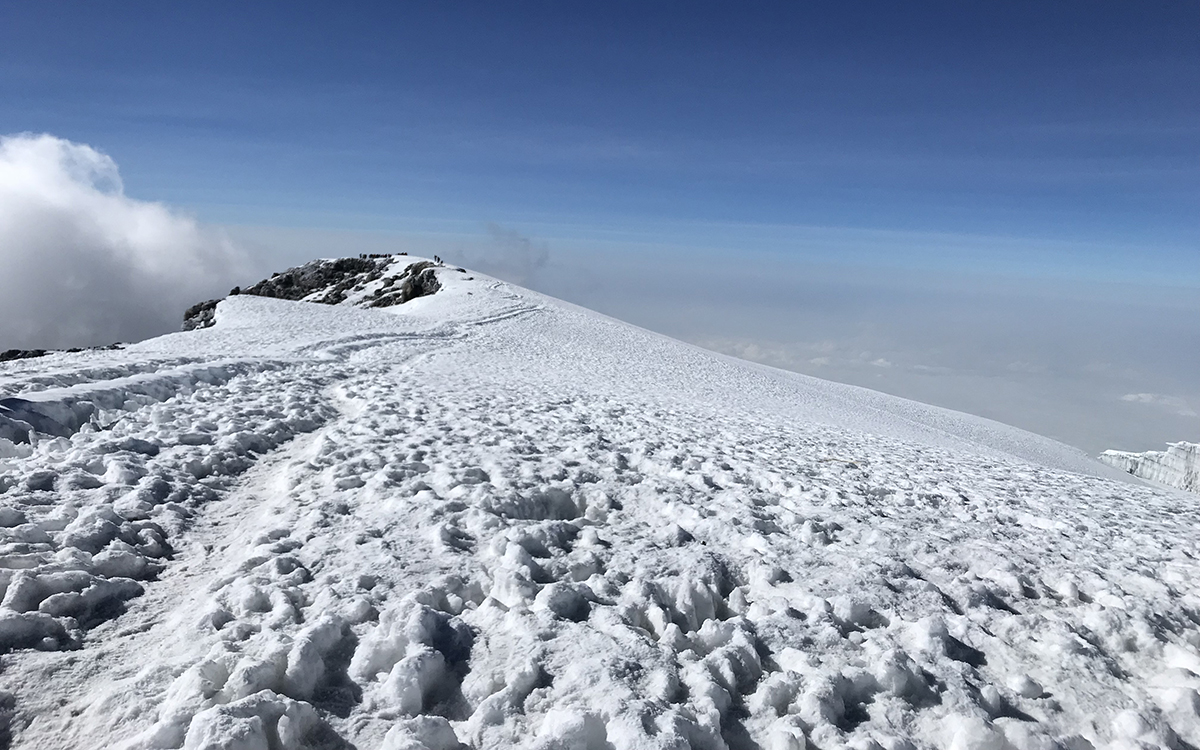Self-Discovery—or Lack Thereof—on Mt. Kilimanjaro
What happens when you don’t "find yourself” on the mountain?

Photos courtesy of Elizabeth Weingarten
On the fifth day of my eight-day hike up Mt. Kilimanjaro, I met a former para-Olympic wheelchair basketball player with a prosthetic leg. He was embarking on a three-day summit bid as part of a larger quest to climb the world’s seven highest peaks. As I shivered in my parka and interrogated him about his most memorable expeditions, he shared a story about a young woman he’d met on a South Pole expedition. She was a self-described “trust fund baby” on the trip to “find herself,” he scoffed. According to this mountaineer, she’d come completely unprepared, leaving him and another team member to shoulder all of her supplies as they bobsledded across the snow and ice.
I laughed and rolled my eyes to signal that I, too, was disgusted with this dumb rich chick. But there was a little part of me that understood her. No, I’m not wealthy by trust fund baby standards, nor do I have any desire to traverse Antarctica. But I've more than once set out on outdoorsy expeditions hoping for, even expecting, some moment of self-discovery, of awakening. I’ll admit it: I sometimes hike in pursuit of a full-blown epiphany.
Kilimanjaro was no different. After three years spent dreaming about (and saving for) the hike, I decided to climb it the week of my 30th birthday—the perfect moment to figure out what the hell I was doing with my life. Maybe if I just inhaled enough mountain air and stayed off wifi for several days I would finally just know how to turn my musings into a book proposal, whether I want to start a family, if I should go to grad school, and how to let go of my fear of conflict and ever-present imposter syndrome. Over so many hours of hiking and reflecting, I figured answers to these massive questions would form naturally—nebulous at first, but then crystallizing as I climbed above the clouds.

This particular set of expectations likely sprung from my steady diet of nature fairy tales that follow this precise arc. “I only went out for a walk and finally concluded to stay out 'til sundown,” the naturalist and explorer John Muir wrote famously. “For going out, I found, was really going in.” In her diary, Anne Frank confided in her belief that nature “brings solace in all troubles … the best remedy for those who are afraid, lonely or unhappy is to go outside, somewhere where they can be quite alone with the heavens, nature and God.” And Einstein told us, “Look deep into nature and you will understand everything.” From Thoreau’s Walden to Cheryl Strayed’s Wild to John Krakauer’s Into Thin Air, I’ve long devoured the trope of self-discovery and transcendence in nature.
Part of the reason these stories and proclamations are so captivating is because they follow the classic narrative archetype of the hero’s journey—the hero is called to adventure, and journeys into the chaotic unknown. As she conquers her unruly environment, she also creates meaning from it, learning something illuminating about her true nature, purpose, and path forward. Stories that juxtapose this ancient archetype onto nature experiences are compelling because they feel accessible: The path to self-discovery could be through your local park or forest preserve. Add to this, too, the scientific research suggesting that we are happier, more creative, and clearer thinkers when we spend time in nature. As well as the fact that the trail up a mountain is littered with clichés about how to approach any life challenge (preferably one small step at a time, looking forward and not back, and remembering that it’s not about the destination but the journey). In other words, opting outside is saddled with a lot of hype and great expectations.
For the first couple days of the trek, I was on high alert for profound thoughts. The most common mantra climbers hear on the mountain is “pole, pole,” which in Swahili means, “slowly, slowly.” This was a challenging directive to follow at first—I’m a fast hiker and walker, even though I know I often miss delightful flora and fauna. On the second day, I tried to walk a little ahead of our guide, who was moving languorously through space. “Slow down, Eliza!” he admonished me, having shortened my name a few days earlier. This became easier as the air grew thinner and the terrain became rockier and steeper.

Was this the secret the mountain was trying to impart and the epiphany I was meant to take away—to slow the hell down? Nah, too lame—and not quite new enough. I was already abundantly aware of my unhelpful proclivity for acceleration.
And in this case, the pace was intentional—rooted in my nerves about what lay ahead. For several weeks before the trip, and up until the summit night, I vibrated with anxiety about whether I would make it to Uhuru Peak, the top of the mountain. I feared debilitating altitude sickness; the summit was 19,341 feet, higher than I’d ever been. To calm myself down, and also to hopefully coax out some profundity, I was trying to jot down daily notes in the tiny branded notebook our tour company had gifted us. I wrote such gems as, “constantly reminded how much traveling is about patience” and “damn it’s getting cold!” By the time I was back in the tent and ready to write, it was hard not to fall asleep after a few desultory sentences.
On my birthday, three days into the trip, I tried to reflect on the past year, only to discover that reflecting on one’s life is far more difficult when one cannot breathe easily and is feeling light-headed. While still at sea level, I'd imagined that as I ascended through the rainforest, and then the heather zone, into the rocky, otherworldly terrain close to base camp, the clearer and more profound my thoughts would become. But as it turned out, thinking and reflecting was happening less and less by the hour, actually. Far from considering a five-year plan, I became increasingly focused on surviving to the next day. My deepest thoughts revolved around when I might eat my next snack, and how much longer I could take the unremitting chatter of one of the members of our group. I thought about the ultra-Zen words of Scottish naturalist Nan Shepherd: “Often the mountain gives itself most completely when I have no destination, when I reach nowhere in particular, but have gone out merely to be with the mountain as one visits a friend with no intention but to be with him,” she wrote in The Living Mountain. It’s kind of like that impossible-to-follow dating advice—it’s only when you stop looking for a partner that you find them.

Our summit bid began around midnight on the sixth day. After sleeping for a couple of hours, we began what we knew would be at least a seven- or eight-hour journey to the top, starting with a steep rock scramble. As I climbed, I gazed back at the line of what seemed like hundreds of fellow hikers in head lamps, many led by guides singing traditional Tanzanian songs; we looked like zealots on a pilgrimage.
Besides a general appreciation for the beauty of my surroundings—the gloss of moonlight, the piercing pink sunrise, light coruscating across corrugated snow—I had very few thoughts. I could no longer expend energy on anxiety or fear. It would only slow me down, or cause me to lose my footing on the icy ascent. Without really intending to (oh hey, Nan Shepherd!), I left my inner world to commune with the mountain. I felt like I was floating—kind of like those days when you are either so tired or hungover that your stress melts away, because you don’t have the energy (or brain cells) to feel it.
At the summit, I looked out over snowy valleys and icy turrets, dug my camera out of my bag and sidled up to the famous sign to take the requisite photos. I felt a mix of joy and disbelief, not unlike the sensation during a dream when you realize you can fly. I wondered how my new para-Olympian mountain pal had felt when he reached the peak a couple of days earlier. Was he, too, motivated to summit each mountain by the search for meaning or personal growth?
On the plane ride home, I analyzed the experience like a scientist reviewing new research results. What had I learned about myself? And did it matter?
The results were inconclusive—I’d need more trials, maybe a lifetime of them, to really answer those questions. I went into nature and did not, at least this time, uncover some deep well of knowledge within. Instead, I discovered how to get outside myself—how to escape, at least for a while, the constant whirring of self-doubt and fear within my brain. When I came back in, I found it was a little quieter; after all, I’d survived for quite some time without it.

 The Magazine of The Sierra Club
The Magazine of The Sierra Club



